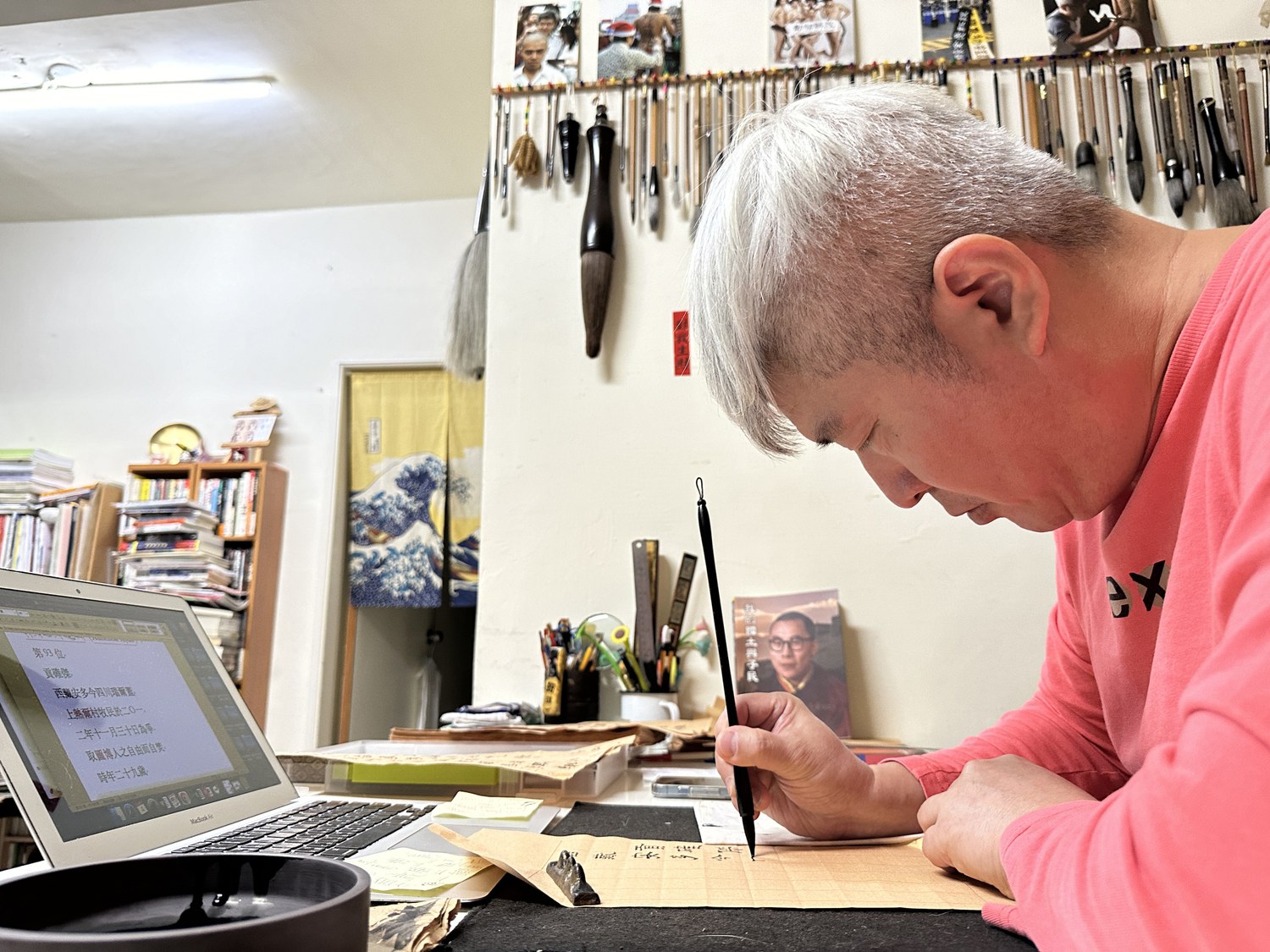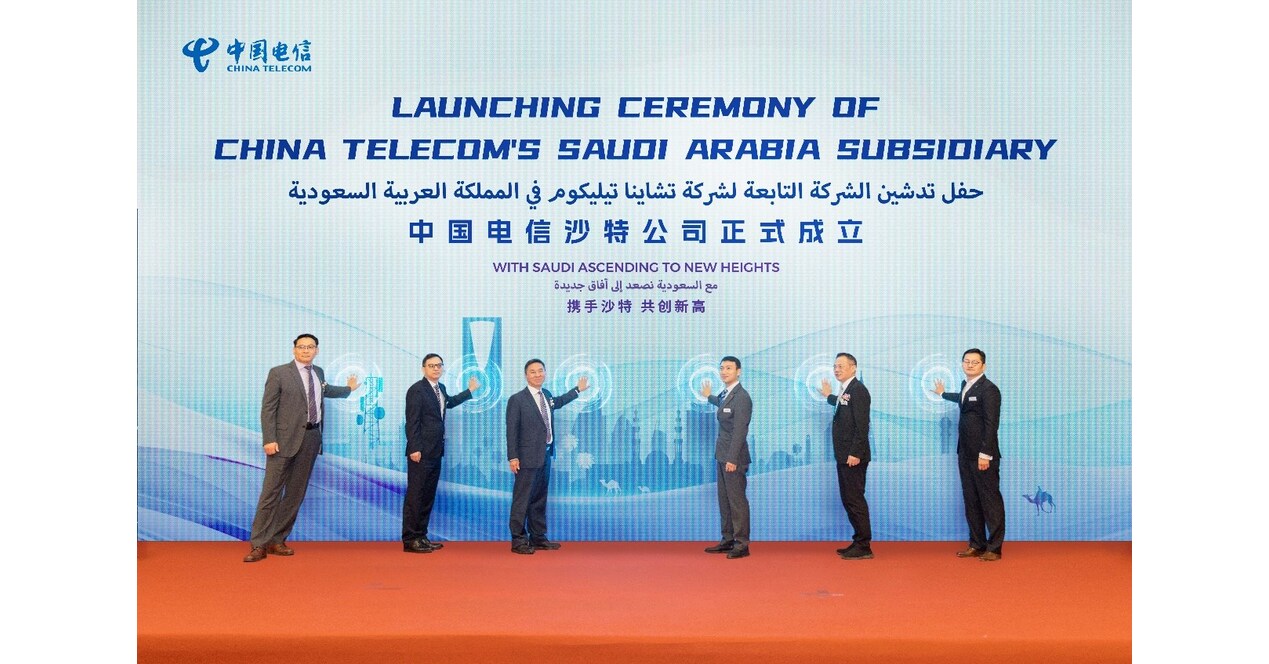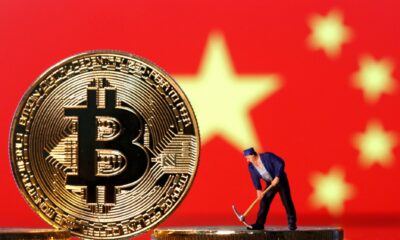China
Taiwan calligraphy exhibit honors Tibetans who self-immolated

On Sunday, Tibetans around the world will be protesting outside Chinese embassies around the world to mark International Human Rights Day.
There is no Chinese Embassy in democratic Taiwan, so the Dalai Lama Foundation will exhibit 166 works of calligraphy by Ho Tsung-hsun, with prayers and chants from five Buddhist teachers honoring the “heroes and martyrs” of the Tibetan resistance movement instead.
The exhibit – titled “Those Who Give Fearlessly” – will honor 166 Tibetans inside and outside China who have set themselves on fire as an act of resistance to Chinese Communist Party rule, and in pursuit of freedom, Ho told Radio Free Asia in a recent interview.
“I was very worried when I was doing this that people would think that I was encouraging self-immolation,” Ho said. “But these things happened – that’s a fact.”
“You can’t erase an entire nationality from the historical record who have made such sacrifices in pursuit of their freedom,” he said.
Ho made the exhibit not to advocate self-immolation, but to highlight the despair and helplessness of those who use it as a form of protest, he said.
“Self-immolation is a last-ditch choice – there must be so much going on in people’s minds that we can’t understand,” he said. “166 self-immolations in the space of just 10 years is a shocking number.”
“Cheng Nan-jung self-immolated right here in Taiwan, and we still see memorials to him here every year marking that day,” Ho said, in a reference to the 1989 self-immolation of the Taiwanese publisher, in a protest against the lack of free speech under authoritarian, one-party rule by the Kuomintang.
Writing history
Calligraphic inscriptions have been used since ancient times to record important events, whether on stone steles or on paper, Ho said.
He hopes that his imitation of ancient scrolls will pay due respect to the people who burned in the ultimate act of self-sacrifice.
Kelsang Gyaltsen, the Dalai Lama’s envoy to Taiwan, told Radio Free Asia he was moved by Ho’s tribute.
“These Tibetans are heroes as we define them in Tibet,” he said. “The Chinese government demonizes them as insane, or claims they acted out of desperation due to family or economic disputes, but it’s not that. No.”
“They sacrificed themselves for their country, and for their people.”

Kelsang Gyaltsen said the epithet, “Those who give fearlessly” is the highest level of almsgiving in the Buddhist tradition. “It means to give your life for a just cause,” he said.
Many of those who set fire to themselves did so while shouting slogans or leaving statements calling for freedom for Tibetans, or for the return of its exiled spiritual leader, the Dalai Lama, and the protection of Tibetans’ Buddhist and cultural heritage.
Some inscribed “Independence for Tibet” on their bodies, Kelsang Gyaltsen said.
Anyone who claims that just speaking of the self-immolations means encouraging them is engaging in pro-Beijing “cognitive warfare,” he added.
“Who is it who most wants to forget them? Who doesn’t want us to cherish or remember them? It’s the brutal Chinese Communist Party regime,” he said, calling for the anniversary of the first self-immolation – Feb. 27 – to be marked as “Tibetan Self-Immolation Day.”
Art as protest
Ho, who studied advertising and fine arts, started writing calligraphy in high school 40 years ago.
His calligraphy has graced a number of protests over the last three decades in Taiwan, including environmental protection and anti-nuclear campaigns, educational reform movements and political activism.

He has an abiding memory of one self-immolation – the second to take place in Tibet, in 2009 — in particular.
“Lobsang Phuntsok, who was only 20 years old at the time, self-immolated on March 16, which happened to be my birthday,” Ho said. “From then onwards, it seemed as if our souls were connected, and that was when I started to pay attention and care about what was happening.”
March 16 is also the anniversary of mass protests by Tibetans, including Buddhist monks and nuns in Ngaba, a Tibetan region of China’s southwestern province of Sichuan, in 2008, that were to be a turning point in the movement for a free Tibet.
“I was shocked, saddened and outraged by each self-immolation, especially during the nearly 90 self-immolations that took place in 2012 – at their peak, we were seeing nearly one a week,” Ho said.
Just thinking about the way Lobsang Phutsok died causes him pain to this day, he said.
Ancient style
Ho’s exhibit will display 166 records of self-immolation by Tibetans using paper and a calligraphic style that matches the style of ancient official records.
Each piece is 34 cm long and 18.5 cm wide (13 x 7 inches). Each work shows the person’s name, place of birth, identity and age of self-immolation.
Ho’s exhibit also has the blessing of the Tibetan government-in-exile’s envoy to Taiwan, who suggested he make sure Tibetans are the central subjects of the work, and add the ancient Tibetan place-names from when the region was a sovereign and independent country, alongside the modern place-names that are used under Chinese rule.
One record reads: “Lobsang Tashi, a monk from Amdo in today’s Sichuan, was 24 years old when he set himself on fire on Feb. 27, 2009, to fight for the freedom of Tibetans.”
Every one of the 166 self-immolators, who include elderly in their 80s, 16-year-old students, high-ranking Buddhist teachers, or Rinpoche, monks, nuns, students and women, is given equal weighting in the exhibit, with a word limit of 43 to 46 words each, Ho said.
The process has been a harrowing one at times for Ho, who got horribly stuck on the record for 49-year-old herder Namlha Tsering, the 104th Tibetan to self-immolate.
He kept making errors on this record, missing out words each time he tried to copy it.
“Namlha Tsering…
Read the rest of this article here >>> Taiwan calligraphy exhibit honors Tibetans who self-immolated
China
Strengthening Economic Relations and Opportunities Between China and Malaysia

Malaysia, strategically located in Southeast Asia, is a vital gateway to ASEAN markets. In 2023, China remained Malaysia’s largest trading partner, with bilateral trade at US$190.24 billion, despite a slight decline. China is also the top source of tourists for Malaysia.
Malaysia is strategically located at the heart of Southeast Asia and serves as a gateway to ASEAN’s 650 million people and a combined GDP of US$3.2 trillion. Its geographical advantage positions it as a hub for accessing ASEAN markets and connecting to the Middle East, Australia, and New Zealand.
In 2023, bilateral trade between China and Malaysia amounted to US$190.24 billion. Of this, China’s exports to Malaysia totaled US$87.38 billion, while imports from Malaysia reached US$102.86 billion. China has remained Malaysia’s largest trading partner for 15 consecutive years. Major imports from Malaysia include integrated circuits, computers and their components, palm oil, and plastic products. Key Chinese exports to Malaysia consist of computers and their components, integrated circuits, apparel, and textiles.
China has implemented a unilateral 15-day visa exemption policy for ordinary Malaysian passport holders, while Malaysia offers 30-day visa-free entry for Chinese citizens. According to Malaysian statistics, over 1.47 million Chinese tourists visited Malaysia in 2023, maintaining China’s position for the seventh consecutive year as Malaysia’s largest source of tourists outside ASEAN.
Malaysia was China’s 10th largest global trading partner and the second largest within ASEAN. However, due to factors such as the decline in international commodity prices (including palm oil and natural gas), uncertainties arising from geopolitical conflicts, and a high base from the previous year, China-Malaysia bilateral trade experienced a slight decline in 2023, decreasing by 5.2 percent year on year.
Despite these fluctuations, China remains Malaysia’s primary source of imports and second-largest export destination, underscoring the deep economic ties between the two nations and Malaysia’s pivotal role as China’s second-largest ASEAN trading partner.
China-Malaysia Trade Value, 2019-2023
| This article was first published by China Briefing , which is produced by Dezan Shira & Associates. The firm assists foreign investors throughout Asia from offices across the world, including in in China, Hong Kong, Vietnam, Singapore, and India . Readers may write to info@dezshira.com for more support. |
Read the rest of the original article.
China
Three lessons the west can learn from China’s economic approach to AI

AI is transforming various sectors globally, but adoption differs. China prioritizes speed and practicality, embracing imperfections. The West, seeking perfection, can learn from China’s pragmatic approach to AI integration.
AI is already everywhere, ready to change the way we work and play, how we learn and how we are looked after. From hospitality to healthcare, entertainment to education, AI is transforming the world as we know it.
But it’s developing at a different pace in different parts of the world. In the west, it seems, there is a tendency to aim for perfection, with companies taking their time to refine AI systems before they are implemented.
China, on the other hand, has taken a more pragmatic path, on which speed and adaptability are prioritised over flawless execution. Chinese companies appear more willing to take risks, accept AI’s current limitations and see what happens.
And China’s desire to be the world leader in AI development seems to be working. Here are three important lessons the west can learn from China’s economic strategy towards AI.
1. Embrace imperfection
Many Chinese companies have adopted a “good enough” mentality towards AI, using it even when the technology is not fully developed. This brings risks, but also encourages fast learning.
For example, in 2016, Haidilao, a popular Chinese restaurant chain, introduced “Xiaomei”, an AI system which dealt with customers calling up to make reservations. While Xiaomei is not the most sophisticated AI system (it only understands questions about reservations), it was effective, managing over 50,000 customer interactions a day with a 90% accuracy rate.
It’s not perfect, but it provides a valuable service to the business, proving that AI doesn’t need to be flawless to make a big impact.
2. Make it practical
A key distinction between AI strategies in China and the west is the focus on practical, problem-solving applications. In many western industries, AI is often associated with cutting-edge technology like robot-assisted surgery, or complex predictive algorithms.
While these advances are exciting, they do not always bring immediate impact. China, by contrast, has made significant strides by applying AI to solve more basic needs.
In China, some hospitals use AI to help with routine – but very important – tasks. For instance, in April 2024, Wuhan Union Hospital introduced an AI patient service which acts as a kind of triage nurse for patients using a messaging app.
Patients are asked about their symptoms and medical history. The AI then evaluates the severity of their needs, and prioritises appointments based on urgency and the medical resources available at that time. The results are then relayed to a human doctor who makes the final decision about what happens next.
By helping to ensure that those with the most critical needs are seen first, the system plays a crucial role in improving efficiency and reducing waiting times for patients seeking medical attention. It’s not the most complex technology, but in its first month of use in the hospital’s breast clinic, it reportedly provided over 300 patients with extra consultation time – 70% of whom were patients in urgent need of surgery.
3. Learn from mistakes
China’s rapid adoption of AI hasn’t come without challenges. But failures serve as critical learning experiences.
One cautionary tale over AI implementation comes not from China, but from Japan. When Henn na Hotel in Nagasaki became the world’s first hotel staffed by robots, it received a great deal of attention for its futuristic concept.
But the reality soon fell short of expectations. Churi, the hotel’s in-room assistant robot, frequently misunderstood guest requests, leading to confusion. One guest was reportedly woken up repeatedly because a robot in his room mistakenly understood the sound of his snoring to be a question.
In contrast, many Chinese hotels have taken a more measured approach, opting for simpler yet highly effective robotic solutions. Delivery robots are now commonplace in hotel chains across the country, and while not overly complex, they are adept at navigating hallways and lifts autonomously, bringing meals to guests.
By focusing on specific, high-impact problems, Chinese companies have successfully integrated AI in ways that minimise disruption and maximise usefulness.
The Chinese restaurant chain I mentioned earlier provides another good illustration of this approach. After the success of its chatbot, Haidilao introduced “smart restaurants” equipped with robotic arms and automated food delivery systems. While innovative, the technology struggled during peak hours and lacked the personal touch many customers valued.
Instead of abandoning the project, Haidilao continued to adjust and refine its use of AI. Rather than adopting a fully automated restaurant model, it went for a hybrid approach, combining automation with human staff to enhance the dining experience.
This flexibility in the face of setbacks represents a crucial willingness to pivot and adapt when things don’t go as planned. Overall, China’s pragmatic approach to AI has enabled it to take the lead in many areas, even as the country lags behind the west in terms of technological sophistication. This is driven by a willingness to embrace AI’s imperfections, and then adapt where necessary.
Where speed and adaptability are critical, companies can’t afford to wait for perfect solutions. By embracing AI’s imperfections, focusing on practical applications and real-world feedback, Chinese companies have unlocked the economic value of AI in a way that others are being too timid to emulate.
This article is republished from The Conversation under a Creative Commons license. Read the original article.
Business
China Telecom Gulf Officially Launches Operations in Saudi Arabia for Business Expansion

China Telecom Gulf was launched in Riyadh, enhancing digital cooperation between China and Saudi Arabia under the “Belt and Road Initiative,” with a focus on technological innovation and infrastructure development.
China Telecom Gulf Launches in Riyadh
On November 21, 2024, China Telecom Gulf was officially inaugurated in Riyadh, symbolizing a significant advancement in China Telecom’s internationalization efforts and commitment to the "Belt and Road Initiative." The event was attended by over 100 dignitaries, including Mr. Liu Guiqing, Executive Director of China Telecom Corporation, and Mr. Fawaz from the Industrial and Commercial Bank of China Riyadh Branch, marking a milestone in fostering a shared future between China and Arab nations.
Commitment to Digital Transformation
In his speech, Mr. Liu highlighted China Telecom’s dedication to collaborating with Saudi enterprises and local governments to enhance digital infrastructure. By leveraging its expertise in technologies like 5G and artificial intelligence, the company aims to provide high-quality communication services, thereby driving socio-economic growth in the region.
Strategic Partnerships for Growth
During the launch, China Telecom Gulf signed strategic agreements with several prominent companies, including Saudi Telecom Company and Huawei. These collaborations are geared towards optimizing digital experiences for Saudi customers and contributing to the broader Sino-Saudi cooperation in technology and economic development, solidifying China Telecom’s role in the Middle Eastern telecom landscape.
Source : China Telecom Gulf Officially Launches in Saudi Arabia for Business






